Services on Demand
Journal
Article
Indicators
-
 Cited by SciELO
Cited by SciELO -
 Access statistics
Access statistics
Related links
-
 Cited by Google
Cited by Google -
 Similars in
SciELO
Similars in
SciELO -
 Similars in Google
Similars in Google
Share
Colombian Journal of Anestesiology
Print version ISSN 0120-3347
Rev. colomb. anestesiol. vol.39 no.1 Bogotá Jan./Mar. 2011
https://doi.org/10.5554/rca.v39i1.41
Investigación Científica y Tecnológica
Anesthesia Complications in Renal Transplantation
Daniel Rivera Tocancipá**, Jorman Harvey Tejada Perdomo***, Arley Medina Herrera****, Luz Eneida Martínez****, Nazly Melissa Nieto****
* Anestesiólogo. Profesor asistente de medicina. Anestesiólogo de trasplante renal. Coordinador de Anestesiología y Reanimación de la Universidad Surcolombiana, en Neiva, Colombia, riverato@hotmail.com
** Residente de anestesiología y reanimación, de la Universidad Surcolombiana, en Neiva, Colombia, j1tejadap@yahoo.com
*** Estudiante de Medicina, del décimo semestre, de la Universidad Surcolombiana, en Neiva, Colombia, Arley33@hotmail.com, candylaly@hotmail.com
Recibido: junio 3 de 2010. Enviado para modificaciones: junio 30 de 2010. Aceptado: octubre 9 de 2010.
SUMMARY
Introduction. In a kidney transplant procedure the anesthesiologist is confronted with several pathophysiological changes inherent to the chronic nephropathy. There is a lack of consensus regarding the use of general vs. epidural anesthesia. The latter is a very important approach for postoperative pain control but many anesthesiologists avoid epidural anesthesia due to the risk of puncture-related complications in the light of the special characteristics of that patient population.
Objective. To describe the anesthetic management in renal transplant patients, the frequency of anesthetic complications and the mortality in the first 3 years of the renal transplantation program at the Neiva University Hospital.
Materials and methods. Case series of 54 patients undergoing renal transplantation at the Neiva University Hospital from January 2007 through September 2009.
Results. There were 21 women and 33 men in total, with a mean age of 42.2 years. 15 % had intraoperative complications, with a frequency of 11 % of hemodynamic instability, 1.9 respiratory depression, while 1.9 % experienced failed ex-tubation. 73 % received multimodal anesthesia. Epidural anesthesia was the most common approach for postoperative pain management (70 %) with morphine as the opioid of choice. Overall mortality was 7.4 %.
Conclusions. Multimodal anesthesia is a satisfactory option for patients undergoing renal transplantation. The epidural catheter is an attractive option to deliver both anesthesia and postoperative analgesia. Epidural opioids merit special attention because of their pharmacokinetic-derived risks, particularly those related to respiratory depression.
Keywords: Epidural Anesthesia, General Anesthesia, Kidney Transplantation, Anesthesia. (Source: MeSH, NLM).
INTRODUCTION
Dialysis support, diet recommendations and drugs have all failed to totally rehabilitate the patient with chronic end-stage renal disease. Thus, kidney transplantation is the best available alternative improving survival and quality of life (1). Hematological (2), cardiopulmonary and metabolic disorders (3), inter alia, challenge the transplant anesthesiologist and require special training (4,5).
The advantages of regional anesthesia, i.e., less bleeding, postoperative pain control, no airway invasion in immune suppressed patients and less drug exposure (6), should be weighted against the disadvantages that include neurological complications, epidural hematoma, post-puncture headache and patient discomfort. Regional anesthesia related hypotension must be kept in mind, particularly because the perfusion of the new kidney graft organ is key (7,8). General anesthesia is also used in renal transplant, with no significant differences in terms of kidney function and hemodynamics. (9). The technique selected should be based on a case-by-case evaluation, considering the particular skills of the anesthesiologist (10).
These patients exhibit a high level of perioperative complications including cardiac arrhythmias, coronary disease and heart failure that give rise to hypertension, hypotension, acidosis, hyperpotasemia, uremia and volume overload (11-14).
Postoperative analgesia is of the essence. Pain increases the risk of cardiopulmonary complications. Epidural analgesia has proven to be effective because of a careful administration of morphine or meperidine to prevent the potential accumulation of its metabolites in the absence of function of the transplanted kidney. Morphine releases histamine, while the other opioids are not associated to a significant histamine release (15).
We collected a series of cases with a view to describe the anesthetic management of renal transplantation, the frequency of anesthesia complications and mortality in the first three years of the kidney transplant program at the University Hospital of Neiva.
MATERIALS AND METHODS
Observational study of a series of cases of kidney transplant patients at the University Hospital of Neiva, from January 2007 through September 2009. All patients had complete clinical records. The following factors were determined: age, gender, concomitant diseases, time of evolution of the renal disease, type and length of time in dialysis, donor (cadaveric or live donor), anesthetic technique, anesthetic agent, epidu-ral catheter and time to removal, intraoperative complications and postoperative mortality. The complications were defined as any complication arising up to the immediate post-operative period. Hemodynamic instability was defined as a +20% blood pressure drop vs. the baseline blood pressure or a systolic blood pressure below 90 mmHg.
By applying a documentary review instrument approved by the Hospital's ethics committee, the information was loaded in the database designed in Epi Info 3.3.2. Central trend means were used for the quantitative variables while the nominal qualitative variables used percentages.
RESULTS
Out of 54 patients admitted, 61 % were males. 50 % were between 40 and 60 years old, with a mean age of 42.2 years. The most frequent comorbidity was arterial hypertension (94 %), followed by glomerulonefritis (22 %) and diabetes mellitus (17 %). The time of evolution of the nephropathy was over three years in 45 % of the patients and less than a year in 7 %. 98 % of the patients transplanted were dialyzed prior to surgery (Figure 1). 44 % of the patients transplanted had been in dialysis for over two years and 5.6 % less than six months. Just one living donor transplantation patient - the donor was a family member - (2 %), who experienced acute rejection, had to be transplanted four months later with a cadaveric donor.
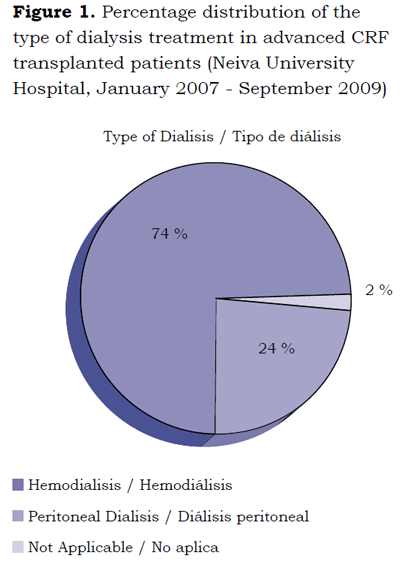
Remifentanil was the opioid of choice (80 %) as the basis for the general balanced anesthesia (Figure 2). 81 % of the patients had an epidural catheter and 50% of them were removed before 72 hours (Figure 3). Morphine was the opioid used for postoperative analgesia and in 70% of the cases it was administered through an epi-dural approach. The rate of intraoperative complications was 15 % and hemodynamic instability was the most frequent complication (11 %). The rate of respiratory depression was 1,9 %. It occurred in a patient within 24 hours post-op. The patient had received 4 mg of epidural morphine for post-op analgesia. In one patient, ex-tubation failed and required re-intubation and transfer to the ICU for a programmed extuba-tion (Figure 4).
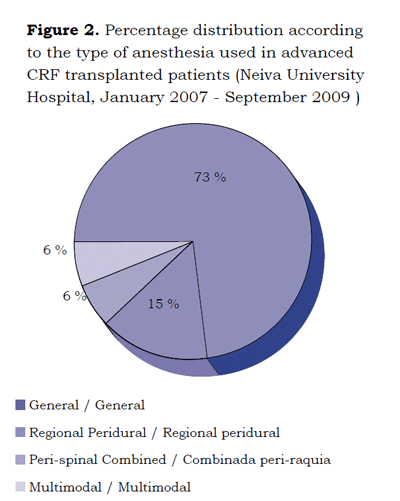
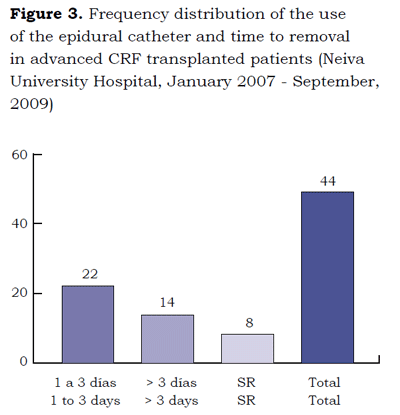
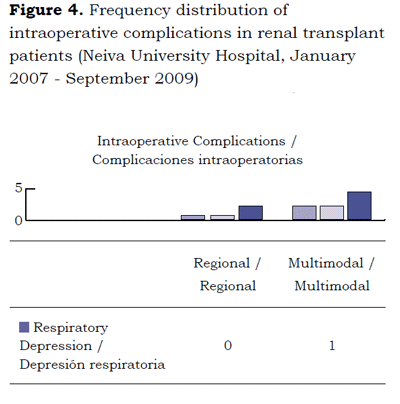
Table 1 illustrates the degree of seriousness of the complications. The failed extubation case, as well as the cases with hemodynamic instability, resulted in an unplanned ICU admission (Figure 5). Overall perioperative mortality was 7.4 % (Figure 6).
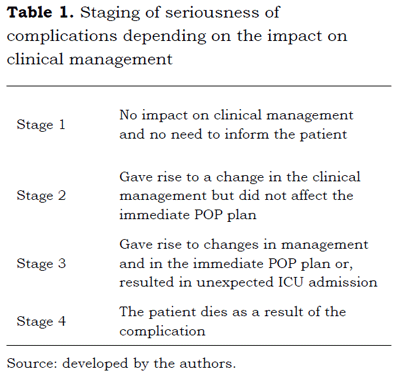
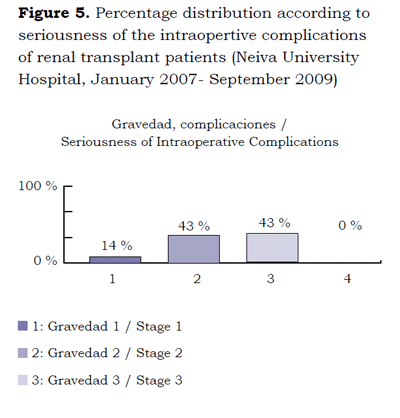
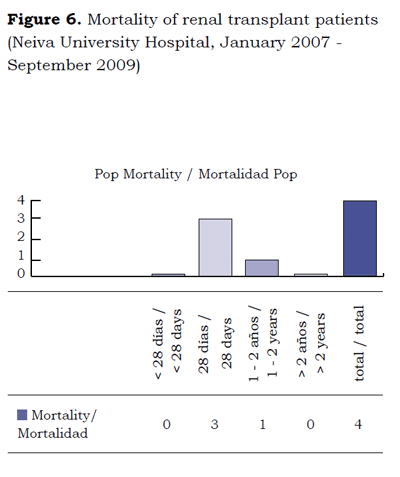
DISCUSSION
Kidney transplantation is a high-risk procedure; hence, the anesthetic and surgical techniques shall be carefully evaluated and safe anesthetic agents with a low frequency of adverse effects must be considered (16). To achieve a careful hemodynamic control and reduce the risk of complications (14,18), the anesthesiologist must recognize each and every step along the surgical procedure and adapt the anesthetic management to the patient's pathophysiological status (17).
Kidney transplantation extends the survival five years as compared to dialysis (70% vs. 30 %). One to five years graft survival in the United States is 89 % and 60% respectively, with a cadaveric donor; the survival rate of the patient from one to five years is 94 % and 80 % respectively (19).
In 2005, the incidence of complications at the Abelardo Buch López Nephrology Institute Habana, Cuba, was 15 % (20). The frequency of complications in our study was also 15 % with hemodynamic instability being the most frequent complication, followed by respiratory depression and failed extubation. Only 1.4 % of the patients had to be transferred to the ICU (21). The most serious difficulties during this period of time were renal vascular thrombosis and graft failure. Urinary output must be monitored to detect early graft dysfunction (22).
Arterial hypotension, particularly following graft revascularization, predisposes to renal function failure and delay. Adequate perioperative blood pressure and intravascular volume must be maintained, with a central venous pressure above 10 mmHg. Vasopressants may only be used as a last resort.
Cosio et al. (23) reported a 7 % post-transplant mortality. In this study, the overall three-year mortality was 7.4 %. The literature reports both regional and general anesthetic techniques in renal transplantation, with no significant differences in terms of morbimortality. Multimodal anesthesia was the method of choice used in 73 % of the cases; the use of an epidural catheter delivered postoperative control. There were no neurological complications, epidural hematoma, or post-puncture headache.
CONCLUSIONS
The overall mortality of kidney transplant patients at the Neiva University Hospital (7.4 %), as well as the peri-opertive complications (15 %), are consistent with the figures reported in the world literature. Multimodal anesthesia is an effective option for managing the renal transplant patient and the use of the epidural catheter is an alternative to assist both the anesthetic technique and post-operative analgesia. Because of the risks involved, particularly respiratory depression, epidural opioids must be used with caution.
REFERENCES
1. Bready LL. Kidney transplantation. Anesthesiol Clin North America. 1989;7:487-513.
2. Linke CL. Anesthesia for renal transplantation. Bull NY Acad Med. 1980;56(5):458-66.
3. Bodziak KA. Recent trends in Kidney intraplantation. En: Hricik DE. Kidney intraplantation. London: Remedica; 2003. p. 1-13.
4. Youngberg JA, Hussey JL, Grogono AW, O'Neill WM, Frentz GD. Renal transplantation in a developing country: anesthesia and other considerations. South Med J. 1984;77(9):1095-7.
5. Bhagani S, Sweny P, Brook G; British HIV Association. Guidelines for kidney transplantation in patients with HIV disease. HIV Med. 2006;7(3):133-9.
6. Carmona P, Peleteiro A, Jimenez C, Gago S, Zaballos M. Anestesia con propofol, remifentanilo y cisatracu-rio en trasplante renal. Rev Esp Anestesiol Reanim. 2003;50(7): 356-9.
7. Pedersen T, Eliasen K, Henriksen E. A prospective study of risk factors and cardiopulmonary complications associated with anaesthesia and surgery: risk indicators of cardiopulmonary morbidity. Acta Anaesthesiol Scand. 1990;34(2):144-55.
8. Hariharan S, Johnson CP, Bresnahan BA, Taranto SE, McIntosh MJ, Stablein D. Improved graft survival after renal transplantation in the United States, 1988 to 1996. N Engl J Med. 2000;342(9): 605-12.
9. SarinKapoor H, Kaur R, Kaur H. Anaesthesia for renal transplant surgery. Acta Anaesthesiol Scand. 2007;51(10):1354-67.
10. Djamali A, Becker YT, Simmons WD, Johnson CA, Premasathian N, Becker BN. Increasing hematocrit reduces early posttransplant cardiovascular risk in diabetic transplant recipients. Transplantation. 2003;76(5):816-20.
11. Goodman WG, Goldin J, Kuizon BD, Yoon C, Gales B, Sider D, et al. Coronary-artery calcification in young adults with end-stage renal disease who are undergoing dialysis. N Engl J Med. 2000;342(20):1478-83.
12. Bonilla A, Pedraza P, Guativa M. Aspectos perio-peratorios del trasplante renal. Rev Col Anest. 2007;35(1):67-74.
13. Elston AC, Bayliss MK, Park GR. Effect of renal failure on drug metabolism by the liver. Br J Anaesth. 1993;71(2):282-90.
14. Humar A, Kerr SR, Ramcharan T, Gillingham KJ, Matas AJ. Peri-operative cardiac morbidity in kidney transplant recipients: incidence and risk factors. Clin Transplant. 2001;15(3):154-8.
15. Hoke JF, Cunningham F, James MK, Muir KT, Hoffman WE. Comparative pharmacokinetics and pharmacodynamics of remifentanil, its principle metabolite (GR90291) and alfentanil in dogs. J Pharmacol Exp Ther. 1997;281(1):226-32.
16. Caralps A, Gil Veraet JM, Vives J, Andreu J, Brulles A, Tornos D, et al. Trasplante renal. Barcelona: Toray; 1983.
17. Eckardt KU. Cardiovascular consequences of renal anaemia and erythropoietin therapy. Nephrol Dial Transplant. 1999;14(5):1317-23.
18. Elston AC, Bayliss MK, Park GR. Effect of renal failure on drug metabolism by the liver. Br J Anaesth. 1993;71(2):282-90.
19. Cosio FG, Ailamir A, Yim S, Pesavento TE, Falkenhain ME, Henry ML. Patient survival after renal transplantation: the impact of dialysis pre-transplant. Kidney Int. 1998;53(3):767-72.
20. Prieto Duarte ML, Garza Rodríguez C, Elizondo Za-pien RM. Experiencia de 7 años de manejo anestésico en trasplante renal. Rev Arg Salud Publica y Nutrición. 2003;2:47-76.
21. Salifu MO, Markell MS. Evaluation of kidney intra-plant recipients and donors. En: Hricik DE. Kidney transplantation. London: Remedica; 2003. p. 55-75.
22. Valentín MO, Garrido G, Martín Escobar E, de la Rosa G, Mahillo B, Domínguez-Gil B, et al. Actividad de donación y trasplante renal en España 2006. Nefrología. 2007;27(4):434-8.
23. Burgos FJ. Presente y futuro del trasplante renal. Actas Urol Esp. 2002;26(10):731-62.
Conflicto de intereses: Ninguno declarado.
1. Bready LL. Kidney transplantation. Anesthesiol Clin North America. 1989;7:487-513. [ Links ]
2. Linke CL. Anesthesia for renal transplantation. Bull NY Acad Med. 1980;56(5):458-66. [ Links ]
3. Bodziak KA. Recent trends in Kidney intraplantation. En: Hricik DE. Kidney intraplantation. London: Remedica; 2003. p. 1-13. [ Links ]
4. Youngberg JA, Hussey JL, Grogono AW, O'Neill WM, Frentz GD. Renal transplantation in a developing country: anesthesia and other considerations. South Med J. 1984;77(9):1095-7. [ Links ]
5. Bhagani S, Sweny P, Brook G; British HIV Association. Guidelines for kidney transplantation in patients with HIV disease. HIV Med. 2006;7(3):133-9. [ Links ]
6. Carmona P, Peleteiro A, Jimenez C, Gago S, Zaballos M. Anestesia con propofol, remifentanilo y cisatracu-rio en trasplante renal. Rev Esp Anestesiol Reanim. 2003;50(7): 356-9. [ Links ]
7. Pedersen T, Eliasen K, Henriksen E. A prospective study of risk factors and cardiopulmonary complications associated with anaesthesia and surgery: risk indicators of cardiopulmonary morbidity. Acta Anaesthesiol Scand. 1990;34(2):144-55. [ Links ]
8. Hariharan S, Johnson CP, Bresnahan BA, Taranto SE, McIntosh MJ, Stablein D. Improved graft survival after renal transplantation in the United States, 1988 to 1996. N Engl J Med. 2000;342(9): 605-12. [ Links ]
9. SarinKapoor H, Kaur R, Kaur H. Anaesthesia for renal transplant surgery. Acta Anaesthesiol Scand. 2007;51(10):1354-67. [ Links ]
10. Djamali A, Becker YT, Simmons WD, Johnson CA, Premasathian N, Becker BN. Increasing hematocrit reduces early posttransplant cardiovascular risk in diabetic transplant recipients. Transplantation. 2003;76(5):816-20. [ Links ]
11. Goodman WG, Goldin J, Kuizon BD, Yoon C, Gales B, Sider D, et al. Coronary-artery calcification in young adults with end-stage renal disease who are undergoing dialysis. N Engl J Med. 2000;342(20):1478-83. [ Links ]
12. Bonilla A, Pedraza P, Guativa M. Aspectos perio-peratorios del trasplante renal. Rev Col Anest. 2007;35(1):67-74. [ Links ]
13. Elston AC, Bayliss MK, Park GR. Effect of renal failure on drug metabolism by the liver. Br J Anaesth. 1993;71(2):282-90. [ Links ]
14. Humar A, Kerr SR, Ramcharan T, Gillingham KJ, Matas AJ. Peri-operative cardiac morbidity in kidney transplant recipients: incidence and risk factors. Clin Transplant. 2001;15(3):154-8. [ Links ]
15. Hoke JF, Cunningham F, James MK, Muir KT, Hoffman WE. Comparative pharmacokinetics and pharmacodynamics of remifentanil, its principle metabolite (GR90291) and alfentanil in dogs. J Pharmacol Exp Ther. 1997;281(1):226-32. [ Links ]
16. Caralps A, Gil Veraet JM, Vives J, Andreu J, Brulles A, Tornos D, et al. Trasplante renal. Barcelona: Toray; 1983. [ Links ]
17. Eckardt KU. Cardiovascular consequences of renal anaemia and erythropoietin therapy. Nephrol Dial Transplant. 1999;14(5):1317-23. [ Links ]
18. Elston AC, Bayliss MK, Park GR. Effect of renal failure on drug metabolism by the liver. Br J Anaesth. 1993;71(2):282-90. [ Links ]
19. Cosio FG, Ailamir A, Yim S, Pesavento TE, Falkenhain ME, Henry ML. Patient survival after renal transplantation: the impact of dialysis pre-transplant. Kidney Int. 1998;53(3):767-72. [ Links ]
20. Prieto Duarte ML, Garza Rodríguez C, Elizondo Za-pien RM. Experiencia de 7 años de manejo anestésico en trasplante renal. Rev Arg Salud Publica y Nutrición. 2003;2:47-76. [ Links ]
21. Salifu MO, Markell MS. Evaluation of kidney intra-plant recipients and donors. En: Hricik DE. Kidney transplantation. London: Remedica; 2003. p. 55-75. [ Links ]
22. Valentín MO, Garrido G, Martín Escobar E, de la Rosa G, Mahillo B, Domínguez-Gil B, et al. Actividad de donación y trasplante renal en España 2006. Nefrología. 2007;27(4):434-8. [ Links ]
23. Burgos FJ. Presente y futuro del trasplante renal. Actas Urol Esp. 2002;26(10):731-62. [ Links ]











 text in
text in 

